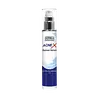What's inside
What's inside
 Key Ingredients
Key Ingredients

 Benefits
Benefits

 Concerns
Concerns

 Ingredients Side-by-side
Ingredients Side-by-side

Water
Skin ConditioningGlycerin
HumectantPropylene Glycol
HumectantCaprylic/Capric Triglyceride
MaskingHydrogenated Phosphatidylcholine
EmulsifyingAlcohol
AntimicrobialRetinol
Skin ConditioningMacadamia Ternifolia Seed Oil
EmollientBrassica Campestris Sterols
EmollientPEG-5 Rapeseed Sterol
CleansingCeteth-3
EmulsifyingCeteth-5
EmulsifyingCholesterol
EmollientSilica
AbrasiveSodium Ascorbyl Phosphate
AntioxidantCetyl Phosphate
Emulsifying1,2-Hexanediol
Skin ConditioningPolysorbate 20
EmulsifyingDisodium EDTA
Paraffinum Liquidum
EmollientButylene Glycol
HumectantNeopentyl Glycol Dicaprate
EmollientPhenyl Trimethicone
Skin ConditioningOctyldodecyl Stearoyl Stearate
EmollientHexyl Laurate
Emollient3-O-Ethyl Ascorbic Acid
Skin ConditioningHydrogenated Lecithin
EmulsifyingPolyglyceryl-3 Methylglucose Distearate
EmulsifyingTocopheryl Acetate
AntioxidantCentella Asiatica Extract
CleansingEthylhexylglycerin
Skin ConditioningDimethicone
EmollientPEG-100 Stearate
Glyceryl Stearate
EmollientDipropylene Glycol
HumectantCetyl Alcohol
EmollientSodium Hyaluronate
HumectantTriethanolamine
BufferingSalicylic Acid
MaskingPhenoxyethanol
PreservativeCarbomer
Emulsion StabilisingStearic Acid
CleansingCera Alba
EmollientBHT
AntioxidantParfum
MaskingWater, Glycerin, Propylene Glycol, Caprylic/Capric Triglyceride, Hydrogenated Phosphatidylcholine, Alcohol, Retinol, Macadamia Ternifolia Seed Oil, Brassica Campestris Sterols, PEG-5 Rapeseed Sterol, Ceteth-3, Ceteth-5, Cholesterol, Silica, Sodium Ascorbyl Phosphate, Cetyl Phosphate, 1,2-Hexanediol, Polysorbate 20, Disodium EDTA, Paraffinum Liquidum, Butylene Glycol, Neopentyl Glycol Dicaprate, Phenyl Trimethicone, Octyldodecyl Stearoyl Stearate, Hexyl Laurate, 3-O-Ethyl Ascorbic Acid, Hydrogenated Lecithin, Polyglyceryl-3 Methylglucose Distearate, Tocopheryl Acetate, Centella Asiatica Extract, Ethylhexylglycerin, Dimethicone, PEG-100 Stearate, Glyceryl Stearate, Dipropylene Glycol, Cetyl Alcohol, Sodium Hyaluronate, Triethanolamine, Salicylic Acid, Phenoxyethanol, Carbomer, Stearic Acid, Cera Alba, BHT, Parfum
 Reviews
Reviews

Ingredients Explained
These ingredients are found in both products.
Ingredients higher up in an ingredient list are typically present in a larger amount.
Glycerin is already naturally found in your skin. It helps moisturize and protect your skin.
A study from 2016 found glycerin to be more effective as a humectant than AHAs and hyaluronic acid.
As a humectant, it helps the skin stay hydrated by pulling moisture to your skin. The low molecular weight of glycerin allows it to pull moisture into the deeper layers of your skin.
Hydrated skin improves your skin barrier; Your skin barrier helps protect against irritants and bacteria.
Glycerin has also been found to have antimicrobial and antiviral properties. Due to these properties, glycerin is often used in wound and burn treatments.
In cosmetics, glycerin is usually derived from plants such as soybean or palm. However, it can also be sourced from animals, such as tallow or animal fat.
This ingredient is organic, colorless, odorless, and non-toxic.
Glycerin is the name for this ingredient in American English. British English uses Glycerol/Glycerine.
Learn more about GlycerinSalicylic Acid (also known as beta hydroxy acid or BHA) is a well-known ingredient for treating skin that struggles with acne and clogged pores. It exfoliates both the skin's surface and deep within the pores to help clear out buildup, control oil, and reduce inflammation.
Unlike AHAs (alpha hydroxy acids), salicylic acid is oil-soluble. This allows it to penetrate into pores which makes it especially effective for treating blackheads and preventing future breakouts.
Salicylic acid is also known for its soothing properties. It has a similar structure to aspirin and can calm inflamed or irritated skin, making it a good option for acne-prone skin that is also sensitive.
Concentrations of 0.5-2% are recognized by the U.S. FDA as an over-the-counter topical acne product.
It can cause irritation and/or dryness if one's skin already has a compromised moisture barrier, so it's best to focus on repairing that before introducing this ingredient into your routine.
While salicylic acid does not increase sun sensitivity, it’s still important to wear sunscreen daily to protect your skin.
If you are looking for the ingredient called BHA or Butylated Hydroxyanisole, click here.
Learn more about Salicylic AcidTocopheryl Acetate is AKA Vitamin E. It is an antioxidant and protects your skin from free radicals. Free radicals damage the skin by breaking down collagen.
One study found using Tocopheryl Acetate with Vitamin C decreased the number of sunburned cells.
Tocopheryl Acetate is commonly found in both skincare and dietary supplements.
Learn more about Tocopheryl AcetateWater. It's the most common cosmetic ingredient of all. You'll usually see it at the top of ingredient lists, meaning that it makes up the largest part of the product.
So why is it so popular? Water most often acts as a solvent - this means that it helps dissolve other ingredients into the formulation.
You'll also recognize water as that liquid we all need to stay alive. If you see this, drink a glass of water. Stay hydrated!
Learn more about Water